UPSC GS 1
Birsa Munda
- News: On the 124th death anniversary of revolutionary tribal leader Birsa Munda, Jharkhand Chief Minister Champai Soren paid tribute to him.
- Early Life and Background:
-
- Birsa Munda was a tribal freedom fighter who played a pivotal role in the Indian independence movement, particularly in the tribal regions of British India.
- He belonged to the Munda tribe in the Chhotanagpur Plateau area.
-
- Role in the Indian Independence Movement:
-
- Munda spearheaded an Indian tribal mass movement that arose in the Bihar and Jharkhand belts in the early 19th century under British colonisation.
- He rallied the tribals to fight against the forceful land grabbing carried out by the British government, which would turn the tribals into bonded labourers and force them into abject poverty.
-
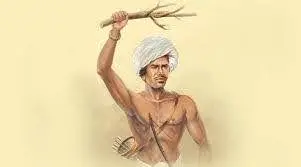
- Munda Rebellion (Ulgulan):
-
- One of Birsa’s notable contributions was the formation of the Munda Rebellion, also known as the Ulgulan, or the Tamar Revolt, in the late 19th century.
- The rebellion was a response to the oppressive policies of the British administration, including the introduction of the Forest Laws that restricted tribal access to their traditional lands, and the imposition of exorbitant taxes.
- Birsa united various tribal communities under the banner of the Munda Raj and led a series of guerrilla warfare campaigns against the British forces.
-
- Legacy and Recognition:
-
- Birsa Munda’s leadership during the Munda Rebellion earned him the title of “Bhagwan” or “Birsa Bhagwan” among his followers.
- His struggle against exploitation led to a significant victory against the British government with the passing of the Chotanagpur Tenancy Act in 1908, which restricted the transfer of land from tribal people to non-tribals.
-
- Religious Influence:
-
- Birsa also played a crucial religious role among the Munda people.
- He founded the faith of Birsait, a blend of animism and indigenous beliefs, which emphasized the worship of a single god.
- He often took inspiration from Munda traditions, Christianity, and Hinduism to guide his followers in rituals and prayers.
- He became their leader and was given the nickname ‘Dharti Aba’ or the father of the earth.
-
- Death and Commemoration:
-
- Birsa Munda died on June 9, 1900, at age 25.
- In recognition of his impact on the national movement, the state of Jharkhand was created on his birth anniversary in 2000.
- November 15, the birth anniversary of Birsa Munda, was declared ‘Janjatiya Gaurav Divas’ by the Central Government in 2021.
-
Read also: UPSC Prelims & Mains: Top Books List to Ace the Exam (2024)
New Caledonia
- News: Recently, the Socialist Kanak National Liberation Front (FLNKS) of New Caledonia urged French President Emmanuel Macron to abandon plans for electoral reform.
- News: French security forces are ramping up efforts to restore order in New Caledonia in response to ongoing and deadly disturbances.
- Geographical Location:
-
- Situated in the southwestern Pacific Ocean, around 1,500 km east of Australia.
- Consists of various islands including Grande Terre, Loyalty Islands, Belep archipelago, Isle of Pines, and remote islands.
-
- Indigenous Inhabitants:
-
- Inhabited for thousands of years by indigenous groups, notably the Melanesian Kanak people.
-
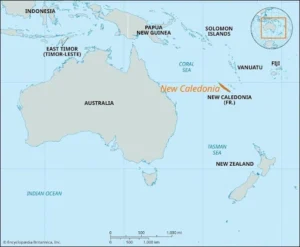
- Political Status:
-
- Autonomy: Classified as a French overseas collectivity, with substantial autonomy according to the 1998 Nouméa Accord.
- Governance: Governed under the Nouméa Accord and the Organic Law of March 1999, defining its constitutional framework and relationship with France.
- Head of State: The President of the French Republic, represented locally by a High Commissioner.
-
- Demographics:
-
- Capital: Nouméa, situated on Grande Terre.
- Population: Approximately 270,000 inhabitants as of 2019, with around 39% being indigenous Kanak people. Other ethnic groups include European Caledonians, Polynesians, and various minority groups.
- Citizenship: Residents hold French and European citizenship, with voting rights in territorial and French national elections.
-
- International Status:
-
- Classified as one of the EU’s Overseas Countries and Territories (OCTs), but not part of the EU, Eurozone, or Schengen area.
-
- Role in the Pacific Community:
-
- Hosts the headquarters of the Secretariat of the Pacific Community, established in 1947 to support economic and social stability in the South Pacific.
- Members include Australia, France, the Netherlands, New Zealand, the United Kingdom, and the United States.
-
Ghataprabha River
- News: Nine people were rescued by locals after a tractor overturned and fell into Ghataprabha River.
- Overview: The Ghataprabha River is a tributary of the Krishna River and flows through the state of Karnataka.
- Course:
-
- The river originates in the Western Ghats at an elevation of 884 meters.
- It flows eastward for a distance of 283 kilometers before merging with the Krishna River.
- The river debouches by 53 meters at Gokak Falls in the Belgaum (Belagavi) District, Karnataka.
-
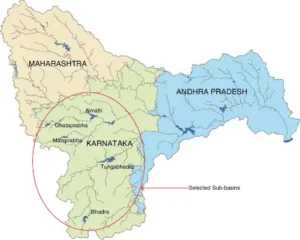
- River Basin: The Ghataprabha River basin covers an area of 8,829 square kilometers, stretching across the states of Karnataka and Maharashtra.
- Tributaries: The Hiranyakeshi River and the Markandeya River are tributaries of the Ghataprabha River.
UPSC GS 2
East Asia Summit
- News: The East Asia Summit (EAS) Senior Officials’ Meeting took place recently in Vientiane, Lao PDR.
- Establishment and Evolution: Initially proposed by former Malaysian PM Mahathir Mohamad in 1991, the East Asia Summit was officially established in 2005 as an initiative led by the Association of Southeast Asian Nations (ASEAN).
- Inaugural Summit: The first EAS summit convened in Kuala Lumpur, Malaysia, marking the commencement of this influential regional forum.
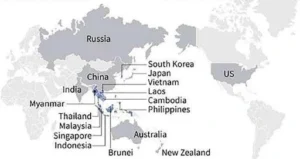
- Strategic Significance:
-
- Leader-Led Forum: Distinguished as the sole leader-led forum within the Indo-Pacific region, the EAS serves as a vital platform for engaging in discussions encompassing political, security, and economic matters of strategic significance.
- Principles: The EAS operates in accordance with fundamental principles such as openness, inclusiveness, adherence to international law, the centrality of ASEAN, and the pivotal role of ASEAN as the driving force behind regional cooperation.
-
- Membership: Comprising 18 members: 10 ASEAN member countries along with 8 dialogue partners, namely Australia, China, India, Japan, New Zealand, the Republic of Korea, Russia, and the United States.
Pradhan Mantri Awas Yojana (PMAY)
- News: The Prime Minister of India has approved government assistance for the construction of three crore rural and urban houses under Pradhan Mantri Awas Yojana (PMAY).
- Pradhan Mantri Awas Yojana (PMAY):
-
- The Pradhan Mantri Awas Yojana (PMAY) was launched on June 25, 2015.
- This centrally sponsored scheme involves financial contributions from both the Union and State governments.
-
- Aim: Providing pucca houses to all eligible beneficiaries by 2022.
- Components: The scheme has two main components: PMAY-U for urban areas and PMAY-G and PMAY-R for rural areas.
- PMAY-U (Urban):
-
- Objective: The objective of PMAY-U is to provide housing for all in urban areas.
- Beneficiaries: The scheme targets the Economically Weaker Section (EWS), Low-Income Group (LIG), and Middle-Income Group (MIG).
- Subsidy Schemes:
- Credit Linked Subsidy Scheme (CLSS): Offers interest subsidies on home loans for EWS, LIG, and MIG categories.
- In-Situ Slum Redevelopment (ISSR): Utilizes land as a resource to provide houses to eligible slum dwellers.
- Affordable Housing in Partnership (AHP): Promotes partnerships with public and private sectors to provide affordable housing.
- Beneficiary-Led Construction (BLC): Provides financial assistance to individuals to construct or enhance their own houses.
-
- PMAY-G (Gramin):
-
- Objective: The objective of PMAY-G is to provide a pucca house with basic amenities to all rural families who are homeless or living in kutcha or dilapidated houses.
- Beneficiaries: Beneficiaries are identified using the Socio-Economic and Caste Census (SECC) 2011.
- Features:
- Financial Assistance: Provides Rs. 1.2 lakh in plain areas and Rs. 1.3 lakh in hilly, difficult, and Integrated Action Plan (IAP) areas.
- Construction: Houses are to be constructed by beneficiaries with technical assistance from the government.
- Convergence with Other Schemes: Encourages convergence with other schemes like Swachh Bharat Mission (SBM) for toilet construction and MGNREGA for wage employment.
-
Clean Economy Investor Forum
- News: An event was recently convened by the Department of Commerce and Invest India with the aim of highlighting diverse investment prospects available in India.
- India Opportunity at IPEF Clean Economy Investor Forum:
- Organizational Details:
-
- Hosts: The Department of Commerce and Invest India collaborated to host a gathering aimed at showcasing diverse investment opportunities within India.
- Venue: The event took place at Marina Bay Sands, Singapore, on June 7, 2024.
- Participant Overview: The forum attracted participation from over 60 global investors and financial institutions, along with the presence of more than 15 Indian firms.
-
- Event Highlights:
-
- India’s Growth Trajectory: The forum underscored India’s remarkable growth rate, which surpasses that of other emerging market economies.
- Startup Ecosystem Dynamics: Noteworthy attention was drawn to the trend of Indian startups increasingly seeking capital access and tax benefits within the domestic market, reflecting a robust entrepreneurial landscape.
- Emphasis on Technological Advancements: Discussions at the event emphasized the pivotal role of artificial intelligence (AI) and data centers in driving India’s future economic growth trajectory.
- Reforms and Regulatory Enhancements: The forum acknowledged ongoing reforms aimed at streamlining regulations, enhancing transparency, and bolstering the Ease of Doing Business index.
- Sustainable Development Focus: Governmental efforts geared towards sustainable infrastructure, climate technology, and renewable energy projects were underscored, aligning with broader objectives aimed at achieving Net Zero targets.
-
- Indo-Pacific Economic Framework for Prosperity (IPEF):
-
- Definition: The Indo-Pacific Economic Framework for Prosperity (IPEF) is an economic initiative launched by U.S. President Joe Biden on May 23, 2022.
- Aim: Provide a platform for countries in the region to collaborate on advancing resilient, sustainable, and inclusive economic growth.
- 14 Members: India, the US, Australia, Brunei Darussalam, Fiji, Indonesia, Japan, the Republic of Korea, Malaysia, New Zealand, Philippines, Singapore, Thailand, and Vietnam.
- 4 Pillars of IPEF:
- Trade
- Supply chain resilience
- Clean economy
- Fair economy (tax and anti-corruption).
- Nodal Agency: The Department of Commerce is the nodal agency for the IPEF engagements.
-
Read this: Paper Leaks in India: Reasons, Consequences and Solutions | UPSC
UPSC GS 3
Sanitary and Phytosanitary Measures (SPS Agreement)
- News: India and the US have resolved their poultry import dispute at the WTO, settling all seven outstanding disputes between them.
- Foundation: The SPS Agreement is a foundational treaty of the World Trade Organization (WTO), which came into effect concurrently with the establishment of the WTO on January 1, 1995.
- Objective: Primarily, it delineates the fundamental regulations governing food safety, as well as the health standards pertaining to animals and plants.
- Basic Regulations:
-
- The agreement lays down the fundamental guidelines dictating how countries can implement measures to safeguard themselves against risks such as diseases and pests transmitted through imported goods.
- It seeks to strike a balance between protecting public health and minimizing barriers to international trade.
-
- Key Provisions:
-
- Scientific Basis: SPS measures must be grounded in scientific principles and risk assessments, except for provisional measures.
- International Standards: Members are encouraged to harmonize their SPS measures with internationally recognized standards established by organizations like the Codex Alimentarius (Food Safety), International Plant Protection Convention (IPPC), and the World Organisation for Animal Health (OIE).
- Non-Discrimination: SPS measures should not unjustly discriminate between trading partners.
- Least Trade-Disruptive Measures: Countries are urged to adopt the least trade-restrictive measures feasible to achieve their desired level of protection.
- Notification Obligations: Nations are mandated to inform the WTO of their SPS measures and furnish details regarding their scientific foundation.
- Dispute Resolution: Disputes arising from SPS measures can be adjudicated through the WTO’s Dispute Settlement Body (DSB), ensuring the enforcement of the agreement’s provisions.
-
Suhelwa Wildlife Sanctuary (SWS)
- News: A new tiger reserve will soon be established in Uttar Pradesh, following evidence of tiger population in the Suhelwa Wildlife Sanctuary (SWS).
- Geographical Range: It is situated across the districts of Shravasti, Balrampur, and Gonda in the state of Uttar Pradesh.
- History: The Suhelwa Wildlife Sanctuary (SWS) was formerly part of the Balrampur Estate under the ownership of the Maharaja of Balrampur until the enactment of the Zamindari Abolition Act in 1952.
- Designation as a Wildlife Sanctuary: Recognized for its ecological significance, SWS attained the status of a Wildlife Sanctuary in the year 1988.
- Extent and Dimensions: Spanning an expansive area of 452 square kilometers, SWS comprises a linear tract of land approximately 120 kilometers in length from east to west, with a width ranging between 6 to 8 kilometers.
- Border Location: Positioned along the Indo-Nepal International Border, the sanctuary forms a vital component of the Bhabar-Terai Ecosystem, renowned for its diverse biodiversity.
- Indigenous Inhabitants: The Tharu tribe, characterized by Mongoloid features, has resided within the vicinity of SWS for generations, contributing to the cultural landscape of the region.
- Ecological Composition: SWS is characterized by a blend of deciduous and semi-evergreen woodlands, which define the sanctuary’s unique ecological profile.
- Diverse Flora: The sanctuary is adorned with a variety of flora, including Bahera, Phaldu, Sal, Teak, Dhamina, Jamun, Shisham, Jigna, Haldu, Asna, and Khair, among others, which contribute to the sanctuary’s rich botanical diversity.
- Wildlife Diversity: SWS serves as a habitat for a diverse array of wildlife species, including tigers, leopards, cheetahs, deer, bears, wolves, hares, jackals, wild boars, sambar, monkeys, langurs, pythons, otters, and various avian species such as black partridges, quails, peacocks, kingfishers, bulbuls, mynahs, eagles, nightingales, cuckoos, and owls, among others.
High Seas Biodiversity Treaty
- News: On World Oceans Day 2024, IUCN chief urges countries to strive for High Seas Biodiversity Treaty.
- Treaty Adoption and Objectives:
-
- Legal Status:
- The United Nations adopted a landmark legally binding treaty in June 2023.
- Objective:
- To protect and manage marine biodiversity in regions beyond national jurisdiction, encompassing approximately two-thirds of the world’s oceans.
- Legal Status:
-
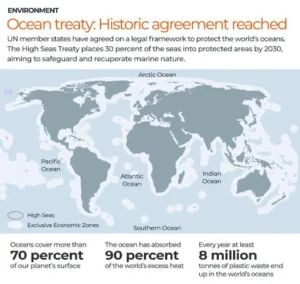
- Importance of High Seas and Current Legal Protection:
-
- Definition of High Seas:
- The high seas refer to vast expanses of the world’s oceans that lie outside national jurisdictions, harboring a rich diversity of marine life.
- Despite their ecological significance, less than 2% of the high seas are currently protected by legal frameworks.
- Definition of High Seas:
-
- Ratification Status and International Recognition:
-
- Ratification Status: As of present, only 7 countries: Belize, Chile, Mauritius, Federated States of Micronesia, Monaco, Palau, and Seychelles—have ratified the treaty.
- Threshold for International Law: The treaty will attain the status of international law upon being signed and ratified by at least 60 countries.
- Notably, India has yet to sign or ratify the treaty.
-
- Key Features of the Treaty:
-
- Establishment of Marine Protected Areas: The treaty emphasizes the establishment of large-scale marine protected areas, with the ambitious goal of conserving 30% of both land and sea by the year 2030.
- Regulation of Marine Genetic Resources: A framework is outlined for the equitable sharing of benefits derived from marine genetic resources, alongside facilitating technology transfer in marine-related endeavors.
- Environmental Impact Assessments: Clear guidelines are provided for conducting environmental impact assessments, ensuring that potential ecological ramifications are thoroughly evaluated prior to any maritime activities.
- Recognition of Indigenous Rights: The treaty mandates the requirement of free, prior, and informed consent from indigenous communities before accessing marine resources, acknowledging and respecting their traditional knowledge and rights.
-
Heat
- News: Heat has impacted various fields such as metallurgy, materials science, mining, refineries, chemical reactions, semiconductor electronics, meteorology, and transportation.
- What is Heat?
- Microscopic View:
-
- Temperature Definition: An object’s temperature is the average kinetic energy of its particles.
- Heat Exchange: When two bodies at different temperatures come into contact, heat flows from the hotter body to the cooler one.
- This flow of thermal energy changes the temperature of both bodies.
-
- Macroscopic View:
-
- Energy Form: Heat is considered a form of energy with specific characteristics.
- Understanding Heat: Thermodynamics and statistical mechanics are key fields used to understand and describe heat.
-
- Heat Transfer in Technology:
-
- Absorption and Dissipation: A medium can absorb heat in one place and release it in another.
- This principle is used in technologies like thermal power plants, nuclear power plants, and air conditioning systems.
-
- Conversion of Heat to Mechanical Energy:
-
- Internal Combustion Engines: Engineers convert heat into mechanical energy to power machines, such as internal combustion engines.
- This convert heat to work using the Carnot cycle, which has four steps: isothermal expansion, isentropic expansion, isothermal compression, and isentropic compression.
- Carnot cycle describes the maximum thermodynamic efficiency an engine converting heat to work can have.
- Thermal Power Plants: Their operation is based on the Rankine cycle, involving four steps: isentropic compression, heat addition, isentropic expansion, and heat removal.
- Rankine Cycle is ideal form for thermal power plants.
-
- Applications of Heat:
-
- Industrial Applications:
- Metallurgy, Mining, and Refineries:
- Heat is extensively utilized in processes such as metallurgy, mining, and refining.
- These industries rely on high temperatures to extract and purify metals, as well as to perform various chemical reactions.
- Chemical Reactions and Semiconductor Electronics:
- Heat plays a crucial role in facilitating chemical reactions necessary for manufacturing a wide range of products.
- In the field of semiconductor electronics, precise thermal conditions are essential for producing integrated circuits and other electronic components.
- Centralized Heating:
- Homes and Offices:
- Heat is employed in centralized heating systems to provide warmth and maintain comfortable indoor temperatures in residential and commercial buildings.
- Engines and Power Generation:
- Internal Combustion Engines (ICEs) and Steam Engines:
- Internal combustion engines and steam engines convert heat into mechanical energy, which powers various types of machinery and equipment.
- Transportation:
- Heat is vital in transportation systems, where it is used in internal combustion engines for vehicles and aircraft.
- Additionally, thermal management is crucial for the operation of electric vehicles, ensuring optimal performance and safety.
-
- Role of Heat in Climate Change:
-
- Mitigation and Adaptation Strategies:
- Heat serves as a focal point in climate change dynamics, necessitating both mitigation and adaptation strategies.
- These approaches aim to address the impact of rising temperatures on global climate patterns.
- Effective Heat Management and Adaptation:
- Effectively managing heat production and adapting to heat waves are critical measures to counteract the adverse consequences of climate change.
- Implementing strategies to mitigate heat-related risks is essential for safeguarding human health and ecosystems.
- Greenhouse Effect and Global Warming:
- The greenhouse effect stands as a fundamental mechanism through which heat contributes to global warming.
- The retention of heat-trapping gases in the Earth’s atmosphere leads to an increase in average global temperatures, exacerbating climate change phenomena.
- Mitigation and Adaptation Strategies:
-
Huntington’s Disease
- News: A team of scientists in the UK have developed new methods to detect Huntington’s disease progression.
- Definition: Huntington’s disease (HD) is a hereditary neurodegenerative disorder characterized by the progressive breakdown of nerve cells in the brain.
- Cause: The disease is caused by a mutation in the huntingtin gene (HTT).
-
- This mutation leads to the production of a defective form of the huntingtin protein, which adversely affects neurons in the brain.
-
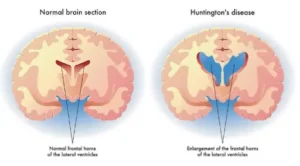
-
-
- Huntingtin protein plays an important role in nerve cells.
-
- Symptoms: Symptoms typically manifest in adulthood and include involuntary movements, cognitive decline, and emotional disturbances.
- Treatment: Currently, Huntington’s disease is incurable.
-
- While treatment cannot reverse or slow down its progression, healthcare providers can offer medications to help manage certain symptoms.
-
Four-Horned Antelope (Tetracerus Quadricornis)
- News: A rare four-horned antelope has been sighted for the first time in Veerangana Durgavati Tiger Reserve in Madhya Pradesh.
- Definition:
-
- The four-horned antelope, also called Chousingha, is a small bovid antelope.
- It is the smallest antelope found in Asia.
-
- Distribution:
-
- This species is endemic to India and Nepal.
- In India, they range from the foothills of the Himalayas in the north to the Deccan Plateau in the south.
-
- Habitat:
-
- Four-horned antelopes mostly occur in open, dry, deciduous forests in hilly terrain.
- They inhabit areas with significant cover from grasses or heavy undergrowth and are typically found close to water bodies.
-
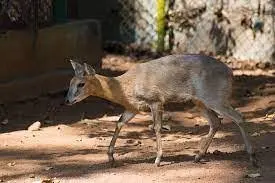
- Features:
-
- Appearance: They have a yellowish-brown to reddish coat and are slender, with small legs and a short tail.
- Horns: These antelopes have four horns, distinguishing them from most other bovids, which have two horns.
- Only males grow horns, with one pair located between the ears and the other on the forehead.
- Behavior: They are usually diurnal and solitary by nature but can be spotted in loose groups of three to four.
-
- Conservation Status:
-
- IUCN Red List: Vulnerable.
-
- Veerangana Durgavati Tiger Reserve:
-
- Location: The reserve is spread across the districts of Sagar, Damoh, and Narsinghpur in Madhya Pradesh, covering an area of 2,339 square kilometers.
- It is the seventh tiger reserve in Madhya Pradesh.
- Composition: The reserve will encompass areas within the Nauradehi Wildlife Sanctuary and Durgavati Wildlife Sanctuary.
- Additionally, a green corridor linking Panna Tiger Reserve (PTR) with Durgavati will be developed to facilitate the natural movement of tigers to the new reserve.[
- Rivers: Parts of the reserve fall under the Narmada and Yamuna River basins.
- Notable Sites: The Singorgarh Fort is located within the reserve.
- Vegetation: The reserve features dry deciduous vegetation.
- Flora: The chief floral elements include Teak, Saja, Dhaora, Ber, and Amla.
- Fauna: The reserve is home to a variety of wildlife, including tigers, leopards, wolves, jackals, Indian foxes, striped hyenas, Nilgai, Chinkara, Chital, Sambhar, Black Buck, Barking deer, Common Langur, and Rhesus Macaque.
- Other six tiger reserves in MP: Kanha, Bandhavgarh, Satpura, Pench, Panna and Sanjay-Dubri.
-
Przewalski Horses
- News: Przewalski horses are being reintroduced into the Kazakh steppe to help preserve this endangered species.
- Overview:
-
- Przewalski horses are commonly referred to as one of the world’s last breeds of wild horses.
- They are native to the Kazakh steppe and are currently classified as an endangered species.
-
- Appearance:
-
- Przewalski horses are stockily built with large heads, shorter legs, and a smaller size compared to domestic horses.
- They are genetically distinct, having 33 chromosome pairs, whereas domestic horses have 32.
-
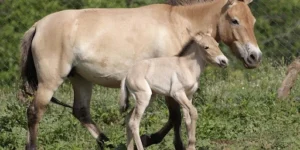
- Behavior:
-
- These horses maintain visual contact with their family and herd at all times and communicate using multiple methods, including vocalizations, scent marking, and a wide range of visual and tactile signals.
-
- Reproduction:
-
- Gestation Period: 11–12 months
- Sexual Maturity: Two years of age
-
- Adaptability:
-
- Przewalski horses are capable of withstanding harsh winters, such as those in Kazakhstan where temperatures can drop below minus 30 degrees Celsius, and food becomes scarce.
-
- Distribution:
-
- Przewalski horses are primarily found in China and Mongolia, with populations also present in France and Russia.
- They have also flourished in the Chornobyl exclusion zone between Belarus and Ukraine.
-
- History and Conservation:
-
- The species is named after the Russian geographer and explorer Nikolay Przhevalsky.
- Once extinct in the wild, Przewalski horses have been reintroduced to their native habitat in Mongolia, particularly in Khustain Nuruu National Park, Takhin Tal Nature Reserve, as well as in Central Asia and Eastern Europe.
-
- Conservation Status: IUCN Status: Endangered (EN).
Facts for Prelims
AIM – ICDK Water Challenge 4.0
- News: Atal Innovation Mission, NITI Aayog (AIM) has announced the launch of two groundbreaking initiatives: the ‘AIM – ICDK Water Challenge 4.0’ and the fifth edition of ‘Innovations for You’ handbook, spotlighting SDG entrepreneurs of India.
- AIM – ICDK Water Challenge 4.0 Overview:
-
- It is an initiative launched by the Atal Innovation Mission (AIM) under NITI Aayog to address critical water-related challenges through innovative solutions.
- This challenge is a collaborative effort with the Innovation Centre Denmark (ICDK) at the Royal Danish Embassy in India.
-
- Objectives:
-
- Addressing Water Challenges: The challenge aims to tackle critical water-related issues through inventive solutions.
- Global Participation: Selected teams from India will join the global Next Generation Digital Action program, engaging with young talents from leading universities and innovation hubs in 9 countries: India, Denmark, Ghana, Kenya, Korea, Tanzania, South Africa, Colombia, and Mexico.
- Emphasis on Sustainability: The program focuses on sustainability, digital solutions, inclusion, and universal design principles.
- Showcasing Innovations: Participants will have the chance to showcase their innovations at the Digital Tech Summit in Copenhagen from October 30th to 31st, 2024, with funding provided by the Government of Denmark.
-
- Participation Tracks: The challenge invites entries in two categories:
-
- Students: Open to student participants.
- Young Entrepreneurs: Open to young entrepreneurs under the age of 35, including early-stage startups, researchers, and young innovators dedicated to driving positive environmental change.
-

